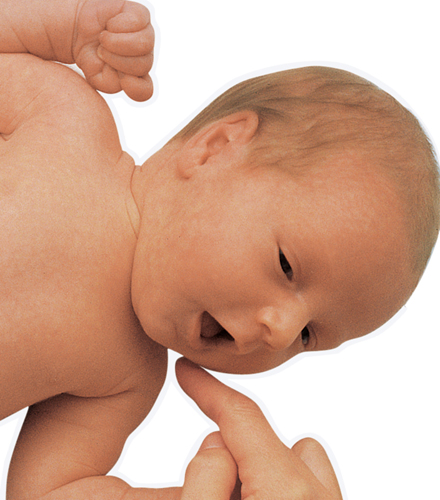The bonding process Getting to know your newborn baby
You may fall in
love with your baby the moment you set eyes on him, or find that your
emotions are initially mixed. Whichever your response, there are ways to
help you and your baby “bond.”
Some quiet time with your partner and baby after the birth is precious as it helps you relax and get to know your new arrival.
Try
not to feel perturbed if you don't experience an instant rush of love
for your baby. Bonding can be a slower process, which doesn't mean that
your relationship will be less special. Nurturing and caring for your
baby daily is equally important.
Apgar score
These tests are performed at 1
minute, 5 minutes, and sometimes 10 minutes after the birth. Your baby's
skin color, heart rate, responses, muscle tone, and breathing are
assessed. In black and Asian babies, the color of the mouth, palms of
the hands, and soles of the feet are checked. Each is given a score of
0, 1, or 2; a total of 7 or more at 1 minute is normal. Below 7 means
that some additional help may be needed.
Table
| Apgar score | 2 | 1 | 0 |
|---|
|
Skin color
| Pink all over | Body pink, extremities blue | Pale/blue all over |
|
Breathing
| Regular, strong cry | Irregular, weak cry | Absent |
|
Pulse/heart rate
| Greater than 100 bpm | Less than 100 bpm | Absent |
|
Movements/muscle tone
| Active | Moderate activity | Limp |
|
Response after certain stimuli
| Crying or grimacing strongly | Moderate reaction or grimace | No response |
Your newborn's appearance
Your baby's appearance
immediately after the birth may not be what you expected. Right after
the birth, the skin can look dark red or purple, but quickly changes to a
lighter color as he begins to breathe air through his lungs for the
first time. His hands and feet may look a little blue for the first
24–48 hours; this is normal, but blue-tinged skin elsewhere at this time
isn't normal and should be assessed. A baby's head shape sometimes
concerns parents; as the baby passes through the birth canal, the bones
of the skull are designed to overlap, which means that after the birth
the head can looked quite pointed. However, this resolves within 24
hours. Sometimes there is bruising on the scalp due to the baby's
position in labor that tends to disappear in the first week.
How your baby looks:
A newborn's
appearance immediately after the birth is quite different than how he
will look in a day or two. Your baby may be covered in the thick, waxy
substance called vernix and may have marks and bruises from the birth
process, which usually disappear within a few days.
Vitamin K An essential vitamin for your baby
After the birth,
although you may decline, your baby will be given an injection of
vitamin K. This is an essential vitamin for helping the blood to clot,
and since babies have little vitamin k at birth and receive very little
of it from their milk diet there is a small risk that they could suffer
internal bleeding. Sources of bleeding may include:
Circumcision
GI tract mucus membranes
Hematoma on skull
Umbilicus
Newborn reflexes
Babies have several reflexes that are present from the moment of birth and are part of their survival skills.
If your baby feels unsupported she will fling out her arms and legs.

Your baby instinctively “roots” for food when you touch her face.

A baby's grip is surprisingly tight.

Your baby steps up and down automatically on a surface.

Startle (moro) reflex.
If a baby's head is not supported, this produces a falling sensation
and she will fling out her limbs. It's important that you always support
your baby's head.
Rooting reflex. If you touch your baby's cheek, she will turn her head in search of food.
Grasp reflex. If you put a finger in your baby's palm, she will grip it tightly with her fingers.
Stepping reflex. If you hold your baby upright on a surface, she will make stepping actions.
NOTE
Don't worry if you
grimace when you see your baby—it's normal to see a wrinkly face covered
in blood, but this is a fleeting moment